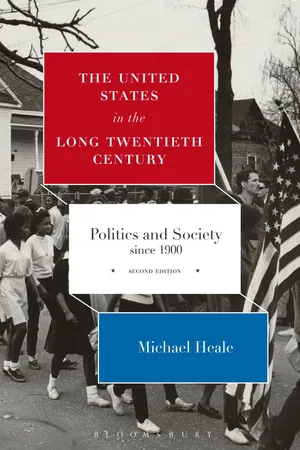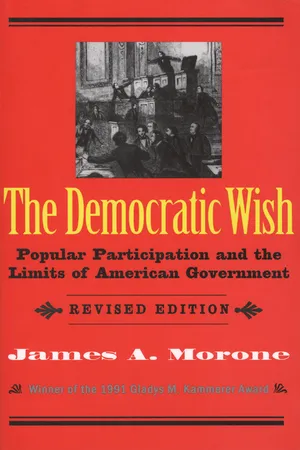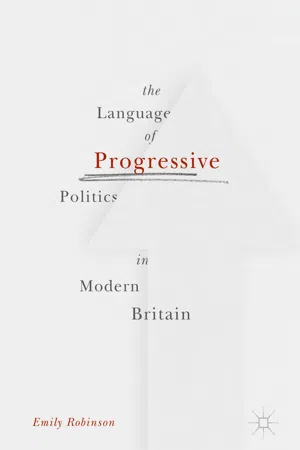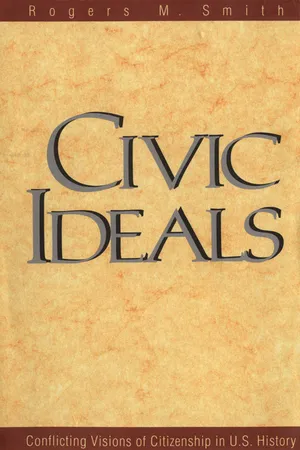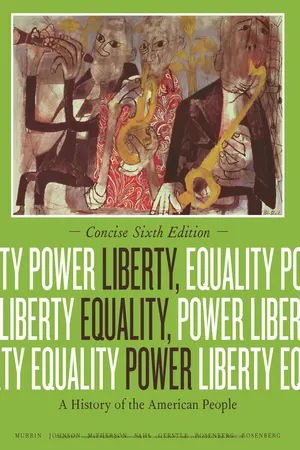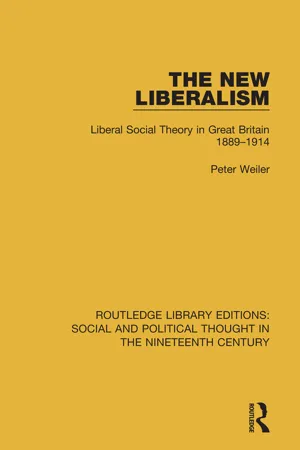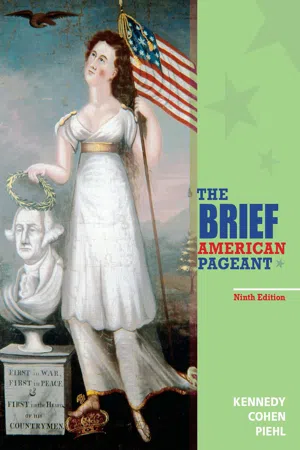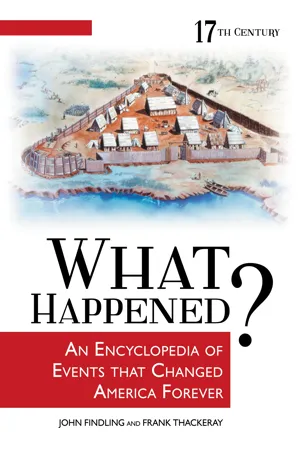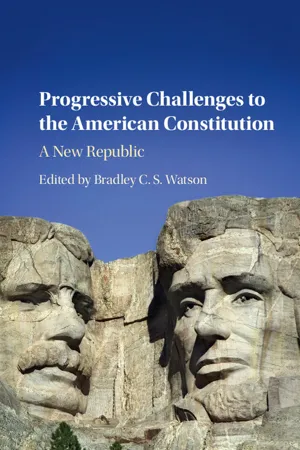History
Progressives in Politics
Progressives in politics refers to a political movement that emerged in the late 19th and early 20th centuries in the United States. Progressives sought to address social and economic inequalities, improve working conditions, and combat political corruption. They advocated for government intervention to regulate big business and protect the welfare of the public, leading to significant reforms in areas such as labor, consumer protection, and women's suffrage.
Written by Perlego with AI-assistance
Related key terms
1 of 5
11 Key excerpts on "Progressives in Politics"
- eBook - PDF
- Paul Boyer, Clifford Clark, Karen Halttunen, Joseph Kett(Authors)
- 2017(Publication Date)
- Cengage Learning EMEA(Publisher)
Women’s clubs embraced reform. Intellectuals challenged the ideological foundations of a business-dominated social order, and journalists exposed municipal corruption and industrialism’s human toll. Throughout America, activists worked to make government more democratic, improve conditions in cities and factories, and curb corporate power. Historians have grouped all these efforts under a single label: “the progressive movement.” In fact, “progressivism” was less a single movement than a spirit of discontent with the status quo and an exciting sense of new social possibilities. International in scope, this spirit found many outlets and addressed many issues. 21-1.1 The Many Faces of Progressivism Who were the progressives, and what reforms did they pursue? The social changes of the era pro-vide clues to the answers. Along with immigration, a growing middle class transformed U.S. cities. From the men and women of this class—mostly white, native-born Protestants—came many of the progressive movement’s leaders and supporters. From 1900 to 1920, the white-collar workforce jumped from 5.1 million to 10.5 million—more than double the growth rate of the labor force as a whole. This burgeoning white-collar class included corporate executives and small-business owners; secretaries, accountants, and sales clerks; civil engi-neers and people in advertising; and professionals such as lawyers, physicians, and teachers. New pro-fessional groups arose, from the American Associa-tion of University Professors (1915) to the American Association of Advertising Agencies (1917). For many middle-class Americans, membership in a national professional society provided a sense of identity that might earlier have come from neigh-borhood, church, or political party. Ambitious, well educated, and valuing social stability, the members of this new middle class were eager to make their influence felt. For middle-class women, the city offered both opportunities and frustrations. - eBook - PDF
The United States in the Long Twentieth Century
Politics and Society since 1900
- Michael Heale(Author)
- 2014(Publication Date)
- Bloomsbury Academic(Publisher)
Not a few were women, taking advantage of their increasing importance to promote a reform ethos. The progressive mood was particularly strong between about 1900 and 1917, when reformers won an unusual influence in city, state and national governments. These progressives did help to shape the new political order, even if they failed to achieve some of their most cherished objectives. Progressivism was more a mood than a movement. The term – coined late in the period – signified a wish to see improvement in American public life and an assumption that improvement had to be helped along a bit. There were professional politicians in both major parties who identified with the progressive persuasion, as did countless journalists, social workers, academics, feminists, trade unionists and businessmen. Progressive activists – like their conservative opponents – tended to be men and women of Anglo-Saxon descent and of the Protestant faith. Working-class constituencies sometimes gave crucial support to reform measures, but middle-class or upper middle-class citizens were usually at the core of the various campaigns. The prosperity of the new century fostered confidence and a popular mood broadly receptive to schemes to bridge the class divide. Fears of insurrection had subsided, while memories of the depression of the early 1890s prompted an interest in averting social discontent. And the processes of change had multiplied the number of professionals eager to apply their skills and placed them at critical junctures in the social structure. * * * Ameliorating class conflict had been a major objective of the religious and humanitarian movements that had emerged in the late nineteenth century (as it had also helped inspire the philanthropic largesse of such wealthy men as John D. 33 THE UNITED STATES IN THE LONG TWENTIETH CENTURY 34 Rockefeller and Andrew Carnegie). Some Protestant clerics resuscitated the old idea that churches might mediate between economy and society. - eBook - PDF
The Democratic Wish
Popular Participation and the Limits of American Government, Revised Edition
- James A. Morone(Author)
- 2008(Publication Date)
- Yale University Press(Publisher)
The Progres-sives won changes ranging from railroad regulation (1887) to women's suffrage (1920). In the process, they transformed American govern-ment, casting it into a recognizably modern form. The administrative changes were linked to reforms that promised to revitalize democracy and return power to the people. 106 The Progressive Movement PROGRESSIVE ASPIRATIONS The Progressive Coalitionpon As the attack on the party state grew into the Progressive movement in the 1880s and 1890s, four political voices can be identified along-side the original Mugwumps. First, a diffuse populist impulse attacked not just political corruption but the economic and political oligarchies it fostered. Emerging corporations, most notoriously the railroads and utilities, flaunted their political accommodations. I wanted the legis-latures of four states, bragged the robber baron Jay Gould, so I made them with my own money. Legislatures—state and national—seemed to be dominated by the interests. An increasing number are Sena-tors because they are rich; a few are rich because they are Senators, wrote James Bryce. As the United States negotiated the transformation from bourgeois to corporate capital, the dislocations and inequity were, not implausibly, projected onto the bosses and the barons. There were no beggars till Vanderbilts and . . . Goulds . . . and Fisks shaped the action of Congress and moulded the purposes of government. Then the few became fabulously rich, the many wretchedly poor. 2 ' This was, of course, the impulse at the center of the Populist crusade. It formed a significant strain of the Progressive tradition, especially in the Mid-west. A second call for reform focused on the inefficiency of the party state. As business and society grew more complex, local merchants became impatient with undelivered mail (especially the railroad mail), inefficiencies in the customs houses, and inadequate municipal services. The critics were urban merchants, not industrial capitalists. - Emily Robinson(Author)
- 2017(Publication Date)
- Palgrave Macmillan(Publisher)
2 It is, instead, the story of one particular word within one national context (albeit one made up of four separate nations). It is a word that historians of the US progressive movement attribute to the municipal 2 politics of nineteenth-century London, 3 but one that has a much longer history than that. And that history is far from parochial. It has been, from the beginning, intimately bound up with questions of race and nation- hood, of Britain’s place in the world, and its relationship with its colonies and competitors. POLITICS ‘Progressive’ seems to play a very particular role in British politics. While it has never (yet) been used as the name of a UK-wide party, it is fre- quently used to describe political divisions. It is one half of an assumed binary: ‘the most basic of all dividing lines is that between progressive and conservative thinkers; it’s a dividing line built on two different responses to the human condition’. 4 This idea of a progressive/conservative divide has been remarkably stable. It has shaped British politics for well over a century—and perhaps nearly two. While ‘progressive’ is a forward-looking term, then, it also carries historical baggage. It invokes former genera- tions of self-described progressives, particularly the so-called left-liberal ‘progressive movement’ of late nineteenth- and early twentieth-century Britain. In contemporary Britain, the parties most clearly identified with ‘progressive’ politics have been Labour and the Liberals/Liberal Democrats, with smaller parties like the Greens and the Scottish National Party joining in recent years, as they have adopted left-of-centre economic programmes. We will see in Chaps. 3 and 4, however, that the seemingly exclusive association of the term with this particular political tradition is something of an illusion, and in Chap. 6 will note the ways in which this connec- tion became established in the late twentieth century, due to the role it played in that political context.- eBook - PDF
Civic Ideals
Conflicting Visions of Citizenship in U.S. History
- Rogers M. Smith(Author)
- 2008(Publication Date)
- Yale University Press(Publisher)
12 Progressivism and the New American Empire, 1898-1912 Though scholars dispute what progressivism was, few deny that both major parties and American politics generally changed dur-ing the first two decades of the twentieth century in ways that com-prise a distinct Progressive Era. The impact of the range of politi-cal, social, and intellectual movements that may be termed progressivism is proven by the 1912 election. 1 In it a Progressive third-party candidate, Theodore Roosevelt, ran against Democrat Woodrow Wilson, who espoused a less nationalistic version of pro-gressivism, and against Roosevelt's former protege, Republican William Howard Taft, a conservative who still supported many of Roosevelt's reforms. Though he was by then reviled by followers of the other two, even Taft falls in a lineage that deserves to be termed right progressivism. Conversely, the surprisingly successful So-cialist candidate that year, Eugene V. Debs, had long shared many positions with left progressives, though he remained more radical. After Wilson won, he set about implementing his version of pro-gressivism until World War I interrupted and modified those ef-forts, sharpening their nationalistic and anti-socialist elements in ways that would have an enduring impact on American citizenship in the twentieth century. 2 Important as those later developments were, by 1912 all the main reformulations of American civic ideologies that would com-pete in the rest of the twentieth century were already visible. They confirm beyond question the persistent, often resurgent appeal of inegalitarian ascriptive civic ideologies, along with egalitarian lib-eral and republican themes, in American politics. Hence it is in 1912 that this historical survey will close. This point is admittedly a bit arbitrary, for the Progressive years represented only the deep- - No longer available |Learn more
Liberty, Equality, Power
A History of the American People, Concise Edition
- John Murrin, Paul Johnson, James McPherson, Alice Fahs(Authors)
- 2013(Publication Date)
- Cengage Learning EMEA(Publisher)
Progressives wanted to cleanse politics of corruption and tame the power of the “ trusts. ” They fought against prostitution, gambling, drinking, and vice. They first appeared in municipal politics, organizing to oust crooked mayors and break up local gas or streetcar monopolies. They then carried their fights to the states and finally to the nation. Progressivism was popular among several groups with distinct, and often conflicting, aims, but most pro-gressives agreed on the need for an activist government to right political, economic, and social wrongs. Some pro-gressives wanted government to become active only long enough to clean up the political process, end drinking, upgrade the electorate, and break up trusts. But these problems were so difficult to solve that many other pro-gressives came to see the federal government as the insti-tution best equipped to solve social problems. They endorsed the notion of a permanently active government — with the power to tax income, regulate industry, protect consumers from fraud, safeguard the environment, and pro-vide social welfare. Since Americans had long been suspi-cious of centralized government, progressives of all stripes had to build a new case for strong government as the pro-tector of liberty and equality. 478 Copyright 2014 Cengage Learning. All Rights Reserved. May not be copied, scanned, or duplicated, in whole or in part. WCN 02-300 P ROGRESSIVISM AND THE PROTESTANT SPIRIT Progressivism emerged first and most strongly among young, mainly Protestant, middle-class Americans who felt alienated from society. Many had been raised in homes where religious conviction was a spur to social action. They were expected to become ministers or missionaries or to serve their church in some other way. They had abandoned this path, but they never lost their zeal for righting moral wrongs and for uplifting the human spirit. - eBook - PDF
The New Liberalism
Liberal Social Theory in Great Britain, 1889-1914
- Peter Weiler(Author)
- 2016(Publication Date)
- Routledge(Publisher)
Their enthusiasm for a Progressive party in the late 1890's reflected their disappointment with the Liberal party of Rosebery and Harcourt. Yet when the Labour party was founded in 1900, they remained Liberals and attempted to influence Liberal policy rather than follow Ramsay MacDonald into truly working class politics. 83 These Liberals were idealists in the literal sense of the term; they believed in the power of ideas. The party was regarded as the expression of a set of ideas, not as a clearing house for the interests of disparate groups. Political change, the growth of a progressive Liberal party, could only be the result, not the cause of intellectual change. "There is nothing so important just now," wrote the Chronicle, "as that the party of progress should find out what it means, what it believes, what it wants." 33 The need for a statement of progressive policy was the primary concern of progressive Liberals. Clarke wrote of "the urgent need of a re-formation and a re-statement of the principles of Progress in terms which shall give due emphasis to the new ideas of social justice and of a clear rational application of these principles in a progressive policy and a pro- gressive party. " 34 In the Progressive Review, and in the Liberal newspapers, then, there was a call for a new ideology which would express the attitude toward reform and state action of the radical left. But the problem for left wing Liberals was to construct an ideology which contained both the new emphasis on "collectivism" and the traditional Liberal concerns for individualism and personal liberty. Progressive Liberals had the same practical goals of ending poverty and unemployment as Labourites and socialists. But they justified their solutions to these problems in terms of a non-socialist ideology first elaborated by T. - eBook - PDF
Powers of the Mind
Mental and Manual Labor in the Contemporary Political Crisis
- Michael Bray(Author)
- 2019(Publication Date)
- transcript Verlag(Publisher)
“It developed the notion of social control into a program of planning and placed the professional expert near the top” (Haber 1964: xii). The Progressives of the early twen-tieth century sought to reform both state and economy in the image of this expertise, establishing a more rational and less divisive polity, less subject to class and partisan conflict, more orderly and well-designed. They sought, in short, a world ruled according to a tacit identification of managerialism, science, and the practices and habits of middle-class pro-fessionals: efficient, productive, objective, wholesome, steering towards the common good. To the extent that other groups failing to embody these ideals, Progressives were “radical in their conviction that other social classes must be transformed” (McGerr 2003: 79, xv). Yet, at the same time, the contradictions internal to their ideals, as to their social position, left Progressives subject to social forces for which they could not fully account, lest they undermine the supposed authority of their expertise or reveal the weakness of its power. In this section, I sketch key elements 76 Powers of the Mind of progressive politics, focusing on its contradictory relations with three social groups: professionals themselves, capital, and the proletariat. 9 The unique social position of professional knowledge workers shaped the contradictory character of their political project from its beginning. The process of professionalization involves an explicit, yet ambiguous, fusion of the individual and the collective: market monopolies over specific forms of knowledge could only be established through a combina-tion of collective organization and state support. - eBook - PDF
The Brief American Pageant
A History of the Republic
- David Kennedy, Lizabeth Cohen, Mel Piehl, , David Kennedy, Lizabeth Cohen, Mel Piehl(Authors)
- 2015(Publication Date)
- Cengage Learning EMEA(Publisher)
Muckraking attacks in Collier’s were substantiated by Dr. Harvey W. Wiley, chief chemist of the Department of Agriculture, who even per-formed experiments on himself. Full of sound and fury, the muckrakers signified much about the nature of the progressive reform movement. They were long on lamentation but stopped short of rev-olutionary remedies. To right social wrongs they counted on publicity and an aroused public conscience, not drastic political change. They sought not to overthrow capitalism but to cleanse it. The cure for the ills of American democ-racy, they earnestly believed, was more democracy. Political Progressivism The question, “Who were the progressives?” evokes contra-dictory answers. Progressive reformers included militarists such as Theodore Roosevelt, who thrilled to the strenuous life, as well as pacifists such as Jane Addams, whose loftiest goals included the abolition of war. Female settlement workers hoping to “Americanize” recent immigrants mobilized alongside labor unionists and enlightened businessmen to strengthen the helping hand of government. In diverse ways, and sometimes with diver-gent aims, the progressives sought to modernize American institutions to achieve two chief goals: to use the state to curb monopoly power and to improve the common person’s conditions of life and labor. Progressives emerged in both major parties, in all regions, and at all levels of government. The truth is that progressivism was less a monolithic minority movement and more a broadly dispersed majority mood. One of the first objectives of progressives was to regain the power that had slipped from the hands of the people into those of the “interests.” These ardent reformers pushed for direct primary elections so as to undercut power-hungry party bosses. They favored the initiative so that voters could directly propose legislation them-selves, thus bypassing the boss-bought state legislatures. - eBook - PDF
- John E. Findling, Frank W. Thackeray, John E. Findling, Frank W. Thackeray(Authors)
- 2010(Publication Date)
- ABC-CLIO(Publisher)
Ithaca, NY: Cornell University Press, . Study of the impact of progressivism on an important northeastern state. McCormick, Richard L. The Party Period and Public Policy: American Politics from the Age of Jackson to the Progressive Era. New York: Oxford University Press, . A study of the changes brought by Progressive politics on U.S. political parties. McGerr, Michael E. The Decline of Popular Politics: The American North, –. New York: Oxford University Press, . Argues that the partisan politics of the Gilded Age was replaced by the politics of personality, despite Progressives’ efforts to create an educated, issue-oriented electorate. Meltzer, Milton. Bread and Roses: The Struggle of American Labor, –. New York: Alfred A. Knopf, . Survey of the development of organized labor. Painter, Nell Irvin. Standing at Armageddon: The United States, –. New York: W. W. Nor- ton, . Survey text from a working-class point of view, with emphasis on political and labor history. Riis, Jacob A. How the Other Half Lives: Studies among the Tenements of New York. New York: Dover, . Originally published in , this was a pioneer photographic exposé of immi- grant poverty in New York City. Weinstein, James. The Corporate Ideal in the Liberal State, –. Boston: Beacon Press, . Radical interpretation asserting that progressivism developed under the banner of cor- porate capitalism and its financial institutions. PROGRESSIVISM, 1901–1914 15 ROBERT LA FOLLETTE (1855–1925) Over the course of a -year political career, “Fighting Bob” La Follette never let the lure of wealth or political power deter him from his successful efforts to champion Progres- sive reforms in Wisconsin and Washington, D.C. Although his passionate commitment to reform earned him the wrath of his opponents during his lifetime, admiration for his courage and appreciation for his accomplishments have greatly enhanced his reputation since his death. - eBook - PDF
Progressive Challenges to the American Constitution
A New Republic
- Bradley C. S. Watson(Author)
- 2017(Publication Date)
- Cambridge University Press(Publisher)
Progressivism emerged from Protestant America, sometimes directly in the form of the Social Gospel, sometimes through secularized thought in the emerging academic social sciences. What put Progressive reforms over the top, however, was their commingling with Catholics and Jews, people adhering to or at least raised in traditions of law and morality that antedated by some time the philosophy of the liberal and progressive John Stuart Mill and antedated even the Constitution of the United States and its Enlightenment forebears. The social solidarity and moral duty they promoted had theoretical foundations in the philosophy of Aristotle, amplified for Catholics in the theology of Thomas Aquinas and the medieval scholastics, and 166 Building the American Welfare State while it is an interesting question – and much too complex for an aside – how Catholic natural law and modern natural rights relate to one another, it is no accident that, in the era when, as James Ceaser explained, 27 Progressive intellectuals had discarded the natural rights foundation of American constitutionalism, Catholics like John Ryan confidently asserted the reality of natural rights, if in an obviously non-Lockean way. As Franklin Roosevelt discarded the Progressives’ audacity in trashing the Constitution, following instead Felix Frankfurter’s policy of claiming the mantle of John Marshall and Alexander Hamilton’s liberal interpretation of the power of the federal government to justify unprecedented policy innovations, 28 so Catholics like Ryan anchored their policy arguments in timeless principles and so signaled permanent standards of judgment by which the results of those policies might be evaluated and reassessed. This lends gravity to the vague optimism of the Progressives and gives policy choice the equilibrium of common sense.
Index pages curate the most relevant extracts from our library of academic textbooks. They’ve been created using an in-house natural language model (NLM), each adding context and meaning to key research topics.

